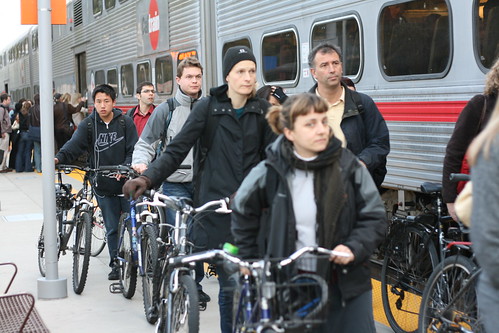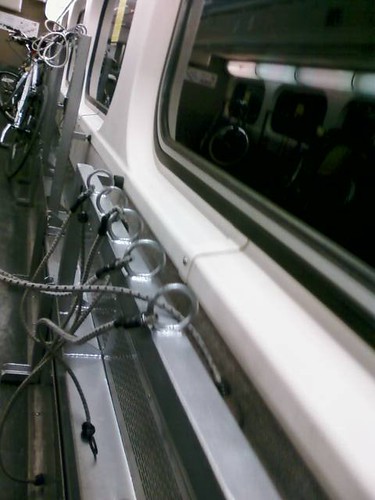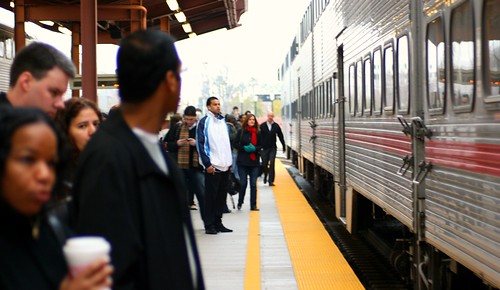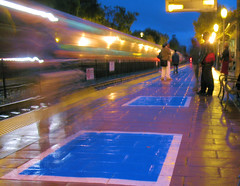Tomorrow (Thursday, February 5, 2009) at 10 AM, the Caltrain Joint Powers Board meets to hear and consider various proposals that Caltrain staff will present on increasing bicycle capacity on board the trains. One of the proposals that Caltrain Operations Director Chuck Harvey and special assistant Mark Simon may give is increasing capacity on the ‘new’ Bombardier bike cars (‘bomb cars’) to 32 bikes by removing all seats from the lower level.
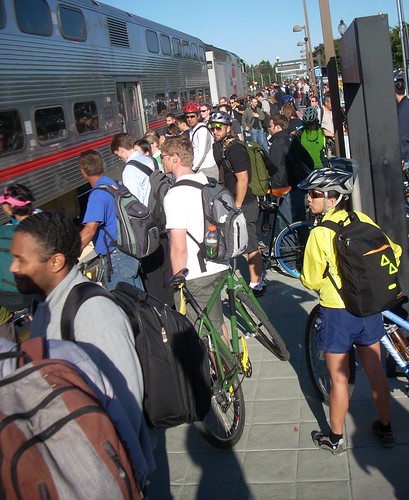
The San Francisco Bicycle Coalition Bikes On Board committee has come out strongly opposed to what they call “Stand or Steal.” Because there are no seats on the bike level, cyclists will either need to stand for their entire trip, or sit out of view of their bikes, risking theft. SFBC member surveys show that bike theft is a major concern for their membership.
The San Francisco Bicycle Coalition counters with their own proposal: All bomb car sets will always have at least two bike cars, and increase bomb car bike capacity by removing seats and adding bike racks to the mezzanine levels. Eventually, the SFBC would like the lower level of all bomb cars converted to bike space.
There are some varying dynamics between morning southbound and northbound Caltrain passengers. In the mornings, relatively few passengers boarding at 4th and King in San Francisco have bikes, leaving hundreds of empty passenger seats, while cyclists are routinely bumped even in the winter. At the San Jose side of things, however, the passenger cars are jam packed, with more crowding on in Sunnyvale and Mountain View before they begin to detrain in Palo Alto and on the Peninsula. The bike cars also are full, but bumping typically doesn’t begin until Sunnyvale on northbound trains.

What will the Silicon Valley Bicycle Coalition propose during tomorrow’s meeting? As things currently stand, the SVBC will also reject “Stand or Steal” and insist on more bike cars on all trains to (1) deal with capacity issues and (2) make capacity more consistent. Currently, you don’t know if you can expect 16 spaces or 64 spaces for bikes on a train. The SVBC will also encourage Caltrain to get creative to come up with some kind of real time notification system for those along the line.
Another idea that’s been floated is increasing capacity on bomb cars to 24 bikes in the lower level; this means fewer seats, but at least a few will be available and a thief won’t know if the bike owner is nearby or now.
Something I would personally like to see: Priority boarding for cyclists on the bike cars. Presently, non-cyclist passengers have boarding priority, and there’s tremendous crowding at the bike car (always the north car) because that’s the train car closest to shuttle bus stops. Cyclists are forced to wait for all other passengers to board because they don’t have the option of boarding in another car, which increases dwell time, or the time the train sits at the station. If cyclists have boarding priority, the other passengers have the option of boarding at different cars. Furthermore, cyclists are more likely to find a seat on the bike car once they board.
Who’s attending this meeting? I’ll be at the Caltrain JPB meeting tomorrow with probably hundreds of other cyclists. Come early if you ride the train: I imagine the trains to San Mateo will be absolutely jam packed for this meeting.

If you show up at the JPB meeting, here are my endorsements:
- Reject “Stand or Steal.”
- Insist on at least two bike cars on every Bombardier (‘bomb’) train set. Caltrain will need to rip seats out of additional cars for this to happen. Eventually, I think Caltrain should make every Bomb car a bike car on the lower level.
- Additional room on Gallery (old style) cars by removing the lower seats.
Disclosure: I’m on the “Caltrain Working Group” for the Silicon Valley Bicycle Coalition. I mostly show up at meetings as people much smarter than me talk about the issues of bikes on board Caltrain.
Resources:
